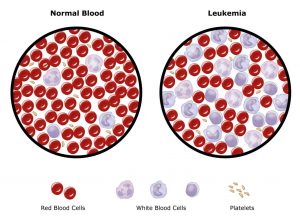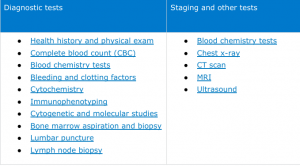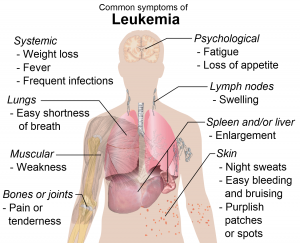What is leukemia all about?
Leukemia is cancer of the body’s blood-forming tissues, including the bone marrow and the lymphatic system. Leukemia usually involves white blood cells. Your white blood cells are infection fighters, they usually divide and grow in an organized way, as your body needs them. But in people with leukemia, the bone marrow produces abnormal white blood cells, which don’t function properly. When a person is infected by leukemia the WBC count increases in his body.

Impact of the disease on individuals and society:
Individuals :
Leukemia affects the body by causing a number of problems. As the bone marrow becomes is filled with more and more leukemia cells, there isn’t enough space to make healthy blood cells. Low levels of platelets mean that cuts or any other injury heal very slowly. Low levels of red blood cells mean that the body doesn’t get enough oxygen and flow of oxygen. The RBC count decreases, so people feel more tired and out of breath. A big problem is that leukemia cells can’t do jobs like fighting germs that usually white blood cells do. This means people are more likely to get other infections.
Society :
The impacts of Leukemia on the society is that when a person is infected by this disease other people also get very alert as the disease is not very common and familiar, this disease has many impacts on the person which alerts other people and makes them familiar to the disease. This results in people taking more precautions.
What techniques can be used to diagnose the disease?
A blood test showing an abnormal white cell count may suggest the diagnosis. When a blood test shows that the count of WBC has increased and the count of RBC has decreased, may suggest that a person is suffering from leukemia. To verify that the diagnosis is correct and identify the specific type of leukemia, a needle biopsy and aspiration of bone marrow from a pelvic bone will need to be done to test for leukemic cells, DNA markers, and chromosome alterations in the bone marrow.
The following tests are commonly used to rule out or diagnose leukemia.

Which other systems could be affected?
Leukemia (Blood Cancer) Leukemia starts in the soft, internal part of the bones (bone marrow), but regularly runs swiftly into the blood. It can then reach to other parts of the body, such as the lymph nodes, spleen, liver, central nervous system, and other organs.

How can transplantation or any other scientific advances play an important role in the treatment of the disease?
Transplantations such as transplanting blood of the whole body play a very important role and also all the technological advances without all these such diseases as leukemia cannot be treated.
In stem cell transplantation, high doses of chemotherapy and/or radiation are given to kill leukemia cells along with normal bone marrow. Then, transplant stem cells are passed by an intravenous infusion. The stem cells travel to the bone marrow and start building new blood cells.

Discuss the implications (ethical, social, economic, political, cultural or geographical) of using transplantation or any other scientific advances to cure the disease.
Chemotherapy is the treatment of drugs that destroy rapidly separating cells such as leukemia or other cancer cells. Chemotherapy may be practiced orally in pill or tablet form, or it may be performed via a catheter or intravenous line straight into the bloodstream.
Radiation therapy uses high energy radiation to focus on cancer cells. Radiation therapy may be used in the treatment of leukemia that has spread to the brain, or it may be used to target the spleen or other areas where leukemia cells have accumulated.
These kinds of treatments have their implications economically. These treatments are very expensive and only rich people can afford it. The people who are poor or middle-class cannot afford these treatments.
By a social point of view, these treatments need very skilled doctors and cannot be performed by anyone. To treatments cannot be performed in many hospitals, the hospitals with the license can only treat people with these treatments.
One of the challenging issues for the medical organization in organ transplantation is the religious and cultural aspects of organ donation among various populations. It is well-known that these beliefs in religious countries, especially in Asian regions, play a crucial role in behavior and decision making regarding organ donation.
MLA 7 Citation :
“Stem Cell Transplant For Acute Myeloid Leukemia (AML).” Cancer.org. N.p., 2019. Web. 5 Apr. 2019.
Raymaakers, Karen. “Symptoms Of Leukemia.” www.verywellhealth.com. N.p., 2018. Web. 5 Apr. 2019.
“Leukemia.” www.mayoclinic.org. N.p., 2019. Web. 5 Apr. 2019.
“National Cancer Institute.” Cnacer.gov. N.p., 2019. Web. 5 Apr. 2019.
“Leukemia.” www.mayoclinic.org. N.p., 2019. Web. 5 Apr. 2019.
Health, Jumo. “How Does Leukemia Affect The Body?.” Share Care. N.p., 2019. Web. 5 Apr. 2019.
“Cancer Fact Sheets.” idph. N.p., 2019. Web. 5 Apr. 2019.